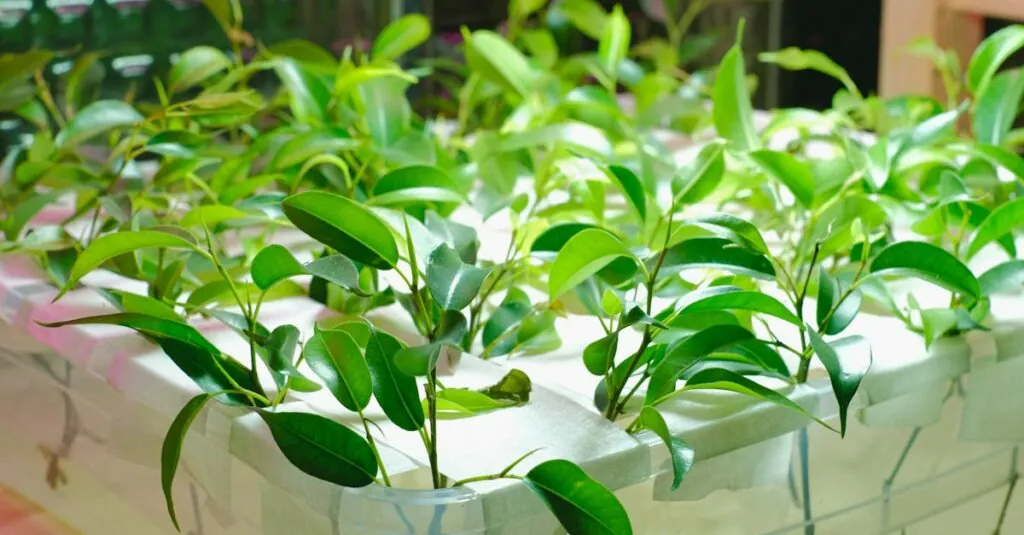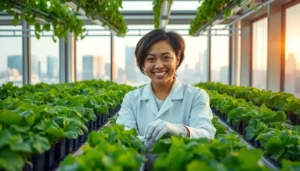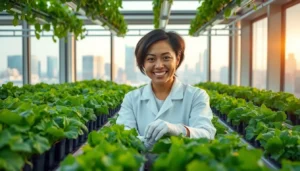Table of Contents
ToggleImagine growing fresh herbs and vibrant veggies without soil, all while saving water and space. Sounds like magic? Welcome to the world of hydroponics systems, where plants thrive in nutrient-rich water instead of dirt. This innovative approach has gardeners and foodies buzzing, and for good reason.
Overview Of Hydroponics Systems
Hydroponics systems offer a sustainable way to cultivate plants by utilizing nutrient-rich water instead of soil. Many growers appreciate the efficiency this method provides, especially in urban environments where space is limited. Various types of hydroponic systems exist, including nutrient film technique (NFT), deep water culture (DWC), and aeroponics, each with distinct advantages.
NFT systems circulate a thin film of nutrient solution over plant roots, ensuring they receive adequate moisture and nutrients. DWC systems submerge plant roots directly in oxygenated nutrient solution, promoting rapid growth. In aeroponics, plants get their nutrients through a fine mist, enhancing oxygen availability and reducing water usage.
Most hydroponics systems allow for year-round cultivation, enabling growers to produce crops regardless of seasonal changes. Rapid plant growth is common, with many crops maturing faster than those grown in traditional soil. This method also reduces pests and diseases, as the controlled environment minimizes exposure to outdoor pathogens.
Accessibility to hydroponics systems has increased due to advancements in technology. Many hobbyists and commercial growers now utilize automated systems with sensors and timers, simplifying management. As knowledge expands, the adoption of hydroponics continues to grow in both residential and agricultural settings.
Cost efficiency stands out as another benefit. Reduced water usage can lead to significant savings over time. Additionally, growers often experience higher yields, making hydroponics an attractive option for those seeking sustainable practices and greater productivity.
Types Of Hydroponics Systems
Hydroponics systems come in various types, each tailored for specific growing needs and environments. Understanding these systems enhances effective plant cultivation.
Deep Water Culture
Deep Water Culture (DWC) features plants suspended in nutrient-rich water. Oxygen is supplied through air stones, ensuring roots receive necessary nutrients and air. Fast plant growth occurs because roots remain submerged, promoting nutrient absorption. This system is particularly effective for leafy greens and herbs, delivering results within weeks. Simplicity in setup and operation makes DWC popular among both amateur and professional growers.
Nutrient Film Technique
Nutrient Film Technique (NFT) allows a thin film of nutrient solution to flow over plant roots. Roots dangle in a sloped channel, ensuring constant access to nutrients and oxygen. Minimal water usage occurs due to recirculation, making NFT an efficient choice. Commonly used for growing vegetables such as lettuce, this system encourages rapid growth. NFT is suitable for growers seeking a compact and resource-efficient hydroponic setup.
Ebb and Flow Systems
Ebb and Flow Systems alternate between flooding and draining the root zone. Nutrient solution fills the growing tray, saturating the roots before draining back into a reservoir. This method ensures roots receive both moisture and air, promoting healthy growth. Versatility makes Ebb and Flow suitable for various plants, from vegetables to flowers. Growers appreciate its balanced approach to nutrient delivery, supporting vigorous plant development.
Wick Systems
Wick Systems utilize capillary action to deliver nutrients to plants. A wick connects the nutrient reservoir to the growing medium, allowing for passive absorption. This system requires minimal components, making it low-maintenance and beginner-friendly. Although slower growing compared to other methods, Wick Systems are ideal for small-scale operations. They work well for herbs and smaller plants, providing an easy entry point into hydroponic gardening.
Advantages Of Hydroponics Systems
Hydroponics systems offer multiple benefits that set them apart from traditional agriculture methods. Notable advantages include space efficiency, water conservation, and faster growth rates.
Space Efficiency
Growing in a hydroponics system maximizes space use. Vertical setups allow for plants to grow upwards, increasing yield per square foot. Containers positioned on shelves or racks make every inch valuable. Urban environments benefit significantly, as limited land can still sustain substantial crops. Additionally, dense planting leads to higher overall outputs. This system attracts gardeners with small plots, enabling productivity where soil gardening may not be feasible.
Water Conservation
Hydroponics systems utilize significantly less water compared to traditional farming. Closed-loop systems continuously recycle water, minimizing waste. Studies indicate that these systems can use up to 90% less water. Reduced evaporation occurs as plants receive nutrients directly through their roots. Consequently, growers experience lower utility costs and environmental impact. Water-efficient practices appeal to those in drought-prone areas or regions with limited water resources.
Faster Growth Rates
Crop growth accelerates in hydroponics systems due to an optimal environment. Nutrient-rich water delivers essential minerals directly to plant roots, promoting rapid development. As a result, leafy greens and herbs can mature in half the time compared to soil-based methods. Controlled conditions also reduce pest and disease risks, allowing plants to thrive. Growers often harvest multiple times a year, increasing production efficiency and profitability.
Challenges Of Hydroponics Systems
Hydroponics systems present unique challenges that growers must navigate. Some of these challenges include initial setup costs and the need for technical knowledge.
Initial Setup Costs
Initial setup costs can be significant for hydroponics systems. Equipment like grow lights, pumps, and nutrient reservoirs often require substantial investment. Systems may range from simple setups costing a few hundred dollars to advanced commercial systems exceeding tens of thousands. In addition, specialized materials for creating a controlled environment, such as climate control systems or premium growing media, add financial considerations. While long-term savings on water and labor may offset these expenses, the upfront financial commitment can deter potential growers.
Technical Knowledge Requirements
Technical knowledge requirements pose another challenge for hydroponics systems. Understanding nutrient management, pH levels, and the specific needs of different plants is essential. Each system type demands varying degrees of knowledge, despite some systems being easier to manage. Beginners might struggle with balancing nutrient solutions and preventing issues such as algae growth and root rot. Continuous learning is crucial, as advancements in hydroponics technology frequently emerge. Access to online resources, workshops, and community support can aid in overcoming these knowledge barriers.
Future Of Hydroponics Systems
Emerging trends in hydroponics systems indicate increased adoption due to technological advancements. Automation leads the way in simplifying nutrient management and monitoring. Smart systems utilize sensors to adjust nutrient levels and track plant health, enhancing productivity for growers. Innovations in lighting, such as LED grow lights, provide energy-efficient solutions while promoting faster plant growth.
Research continues to focus on developing hydroponic strains of crops that yield higher production rates. Greenhouse integration combines hydroponics with controlled environments, optimizing conditions for plant growth year-round. Urban settings see increased popularity of rooftop gardens utilizing hydroponic systems. These setups transform unused spaces into productive areas for food cultivation, supporting local food initiatives.
Sustainability stands out as a priority for future hydroponics practices. Closed-loop systems offer more efficient water and nutrient recycling, contributing to a reduced ecological footprint. The move towards organic hydroponics enhances food quality while appealing to environmentally conscious consumers. Furthermore, collaborative efforts between researchers and commercial growers drive sustainable practices, ensuring food security.
Investment in education and resources will shape the future landscape of hydroponics. Institutions increasingly offer programs to train individuals on hydroponic techniques and technologies. Access to information allows beginners to navigate challenges effectively, promoting a supportive community among growers. As more people engage with hydroponics, potential for innovation and improvement in systems increases.
Market growth alongside consumer demand boosts interest in hydroponics, particularly amid global supply chain disruptions. Younger generations prioritize fresh, locally sourced produce, creating a favorable environment for hydroponic farming. Continuous investment fuels research and development efforts, further enhancing system efficiency and crop variety. This dynamic field presents unlimited opportunities for sustainable agriculture and urban food production.
Conclusion
Hydroponics systems represent a transformative approach to agriculture that addresses modern challenges in food production. With their ability to maximize space and minimize water use, these systems are paving the way for sustainable farming practices. As technology continues to evolve, the accessibility and efficiency of hydroponics will only improve, making it an appealing option for both novice gardeners and seasoned growers.
The future of hydroponics looks bright, with innovations enhancing crop yields and promoting environmentally friendly practices. As more individuals recognize the benefits of growing food in controlled environments, the potential for urban agriculture and local food sourcing expands. Embracing hydroponics could lead to a greener and more sustainable future for food production.







